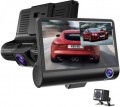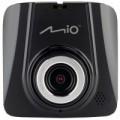Glass mount
Glass mount provided in the model with the corresponding type of installation (see above).
Note that in many models, not the recorder itself is attached to the glass, but the bracket, on which, in turn, the device is installed. To learn how to fix the recorder on the bracket, see "Mounting the recorder". And the options for attaching to glass can be as follows:
—
Sucker. The traditional suction cup, which works due to the reduced pressure between the mount and the glass — as a result, the force of the pressure of the outside air and holds the structure in place. One of the main advantages of this option is “reusability”: the suction cup can be repeatedly stuck and detached at the request of the user, and after removal it leaves practically no traces. However this type of fastening is considered somewhat less reliable than stickers; however, the suction cups used in video recorders are usually of a special design that provides sufficient reliability for practical use. Therefore, this type of mount is extremely popular in modern registrars.
—
Sticker. A plate with a layer of special glue, due to which the entire structure is held on the glass. Such mounts are considered more reliable than suction cups, they are less prone to wear and do not lose effectiveness even with minor damage such as cracks and chips. On the other hand, the sticker is usually installed "once and for all
..." and does not provide the ability to quickly remove the bracket. And although dismantling by itself is possible, however, it will not work to reuse the sticker, and the glass will most likely have to be cleaned from traces of glue. So installing a recorder with such a mount requires special care and attention.
Note that some models of DVRs are supplied immediately with both types of mounts described above in the kit. This allows the user to choose the option of their choice — including changing the suction cup to a sticker, if the need arises.Full HD (1080)
The maximum resolution and frame rate of video taken by the recorder in the
Full HD (1080p) standard.
Many people associate the term Full HD with a resolution of 1920x1080 — and indeed, this resolution is very popular, including among DVRs. However, this standard also covers other options — in particular, 1440x1080 (4:3 aspect ratio) and 1920x540 (halved vertical size). In general, support for this resolution is a good indicator for a modern registrar, indicating that the device belongs to at least an average level.
As for the frame rate, the
higher it is, the smoother and less blurry the video will be, the better the details on moving objects will be visible, and also the more space the footage will take up. It is worth noting here that in low-cost Full HD recorders, shooting can be carried out at very low speeds — 15 fps or even 10 fps. Such a shooting speed allows you to watch video more or less normally, but for a normal display of moving objects, a higher frame rate is still desirable — at least 25 frames / sec.
Field of view
The viewing angle provided by the main camera of the DVR. As a rule, it is indicated along the diagonal of the frame, less often - horizontally, because of this, models with the same numbers in the characteristics may differ somewhat in the actual field of view. So if you have doubts about this, when choosing, it does not hurt to find and watch video samples from different models.
Other things being equal, a wider viewing angle allows you to cover more space, but individual details in the frame are smaller. In addition, wide-angle lenses give geometric distortions of the image (however, DEWARP can be provided to eliminate them, see "Functions"). As for specific figures, viewing angles
up to 120° inclusive are considered relatively small for modern registrars, values of
121 - 140 ° can be called average,
141 - 160 ° are above average, and the most wide-angle models are able to cover a space
of more than 160 °.
ADAS features
—
LDWS (lane control). A system that monitors the car's position within the lane: it monitors the car's position on the road and, if it deviates from the current lane, gives a warning signal, attracting the driver's attention. This signal can literally save the lives of road users if the driver is distracted or falls asleep at the wheel. DVRs with LDWS will be especially useful for those who have to spend a lot of time driving without a break. However, if road markings are of poor quality or absent, this function becomes useless.
—
FCWS(distance control). A system that monitors the distance to the car in front and gives a signal if this distance is critically reduced and a collision is possible. Typically, FCWS is activated at a certain speed (for example, 40 km/h and above), and its sensitivity can be adjusted to suit traffic density. A collision warning is usually displayed and accompanied by an audible signal.
—
LLWS(headlights reminder). A sensor that monitors the level of ambient light; When the light level decreases, LLWS reminds the driver to turn on the headlights. Such a reminder may be useful not only in the dark, but also during the day - for example, in cloudy weather or when entering a tunnel.
—
Sign recognition. Intelligent system for automatic recognition and analysis of road signs. Typically
..., this function aims to recognize speed limit signs and provide advance warning to the driver to adhere to the prescribed speed limits. However, many recorders with a similar function perfectly “see” other road signs, duplicating them to the driver on the screen of the head unit as a kind of safety net.
- Antison. A feature that reduces the risk of falling asleep while driving. When the Antisleep mode is turned on, the recorder, as a rule, periodically plays a special sound signal; in some models this sound stops itself, in others the driver must manually turn off the signal, confirming that he is not sleeping. However, it is worth keeping in mind that even the most advanced Antison system does not provide a complete guarantee against falling asleep while driving. Therefore, the most correct behavior when you are very tired is to stop and rest; This function should be used only in extreme cases.Interior camera
The presence in the design of the device of an additional camera designed
for filming in the car and directed, respectively, in the opposite direction from the main one. The characteristics of such a camera are usually somewhat more modest than the main one, but usually it quite allows you to determine what happened in the cabin at one time or another — this can be a good help in resolving conflict situations.
External camera
One or more remote cameras in the standard equipment of the registrar, used for video recording of the traffic situation behind the car. In the vast majority of cases, the remote camera is attached to the DVR in
one copy. It covers the rear "stern" of the car and is simultaneously used as an assistant when reversing parking — the picture from the camera can be displayed on the DVR screen in real time. There can be
several remote cameras, which provides a wider coverage of the DVR's field of view.
Angle of view
The angle of view of the additional camera of the DVR. Depending on the design and configuration, we can talk about both a remote camera and a camera for filming the interior (see above for both); this nuance should be clarified separately. And the viewing angle can be indicated both horizontally and diagonally, which is why models with the same numbers in the characteristics may differ somewhat in the actual field of view. However, in this case, this difference is not critical.
In theory, a wider field of view allows you to cover more space, but individual details in the frame are smaller. In addition, wide-angle lenses give geometric distortion at the edges of the picture; and the DEWARP technology (see "Features") used to eliminate them is not usually used in additional cameras.
Screen size
The diagonal of the display installed in the DVR.
A large display, on the one hand, provides additional convenience, on the other hand, it affects the dimensions and price of the entire device. Therefore, manufacturers choose a diagonal in such a way that the device can be used normally and at the same time it is not too expensive and bulky. So, for a classic registrar that does not have additional functions, a small display is enough —
2 – 2.5",
1.5 – 2", or even
less : it completely allows you to manage the settings and control what exactly gets into the frame, and to fully view the footage, you still need a computer, TV or other large screen. A size of
2.5 – 3 " by the standards of such devices can already be called average, and screens of
3" or more are typical mainly for fairly advanced models, often with an abundance of additional functions.
Also note that there are models that
do not have a display at all. To control the operation parameters and check the position of the frame, such a recorder is connected to an external device — for example, to a smartphone via Wi-Fi.
Screen resolution
Resolution of the display installed in the recorder.
The higher the resolution (with the same diagonal) — the clearer the image is, but the more expensive the screen itself. At the same time, high resolutions are not needed to set the camera in the desired position and to work with the basic settings of the device. So you should pay attention to this parameter only if you plan to use additional functions that require a high-quality “picture” — for example, a GPS navigator (see “Functions”) or a remote camera that plays the role of a reversing camera.

